Manu Amazon Adventure
Amazon Peru: (ZZ-OUT-ManuB)
URL: https://www.hiddentrails.com/tour/outdoor_peru_manu_adventure_tapirs_macaw.aspx
Introduction
Amazon
Peru
This itinerary offers the complete lowland rainforest experience, taking us by air and then motorized canoe to Manu Wildlife Center, this lodge is located east of the Manu River on the north bank of the Madre de Dios River and offers the Amazon’s finest, in-depth wildlife safari. The lodge is famous for its abundant and varied wildlife, with its own Tapir clay lick, a nearby macaw and parrot clay lick, two nearby oxbow lakes and two tall canopy viewing towers among its impressive highlights. The Lodge contains 22 double-occupancy fully screened private bungalows with hot showers, a large fully screened dining room, and a bar with hammocks for relaxing with the comfort of the our Amazon’s finest wildlife lodge, next day in our rustic, Manu Park Wildlife Center in the heart of the Manu Biosphere Reserve. In Manu we navigate the waters of an isolated oxbow lake, home to Giant Otters, caimans, monkeys and an endless variety of birds. Our trip ends downriver with the Amazon’s finest wildlife viewing opportunities, at Manu Wildlife Center. This lodge offers the finest Tapir viewing in the entire Amazon, as Tapirs are nightly visitors to the lodge’s mud wallow. After a canoe and van journey we return to Cusco aboard in a commercial flight.
Accomodation
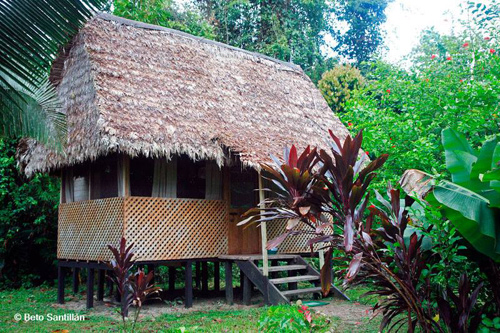
Accommodations
Please, note that no Wi-Fi is available at any of the lodges. There is electricity at the lodges, but it is only available from 06:00am to 09:00pm.
7-day trip Accommodation Itinerary - subject to changes based on availability
Night 1: Hotel in Puerto Maldonado
Night 2: Manu Wildlife Center
Night 3-5: Manu Park Wildlife Center
Night 6: Manu Wildlife Center
6-day trip Accommodation Itinerary - subject to changes based on availability
Night 1: Hotel in Puerto Maldonado
Night 2-5: Manu Wildlife Center
Hotel Cabaña Quinta in Puerto Maldonado
The hotel is surrounded by beautiful trees and offers simple but comfortable accommodations. Each room is equipped with a TV, private bathrooms and free Wi-Fi access. There is also a small outdoor swimming pool where guests can relax.
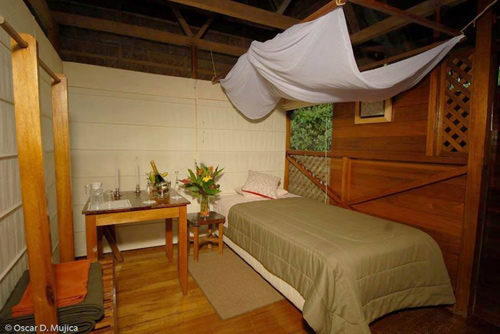
Manu Wildlife Center
The lodge is located in a private, 16,190 ha./40,000-acre rain forest reserve adjacent to the one million-acre protected area named the “Amarakaeri Reserved Zone”. The tapir lick is a comfortable 90 minutes on foot from the lodge, while the macaw lick is a half-hour boat journey plus a short walk away. Visitors will welcome the amenities and comfort of this lodge, with roomy, private bungalows, en suite private bathrooms and tiled hot water showers. Hot and cold water is always available and all toilet facilities are flush.
Manu Wildlife Center consists of 17 bungalows built in the style of, and using the same materials as the local Machiguenga indigenous communities: local wood, bamboo and palm fronds for roofing are used. All materials used have been sustainably harvested or brought in from distant areas.
Each room has a private bathroom, good quality foam mattresses and all beds have cotton sheets and quilts (best for hot tropical conditions). Although all the rooms are screened with imported insect netting, beds are furnished with individual mosquito nets. Furniture includes bedside tables and writing tables.
The bungalows are arranged around a pleasant and well planned Amazonian garden with plants and shrubs that attract birds, butterflies and mammals. The large dining and bar/lounge areas are separate from the other facilities but close to all bungalows and the nearby kitchen area. Food is good and wholesome not gourmet, and we use a variety of fresh vegetables, fruits, grains and meats in our menu. Our cooks are used to providing for vegetarian diets. There is a separate spacious bar and lounge area which is located a short distance from the dining area. A variety of cold non-alcoholic and alcoholic beverages are always available here.
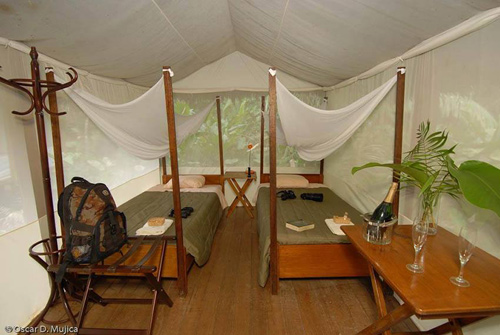
Manu Park Wildlife Center (tented camp)
The center features spacious 9 double-occupancy room-size tents with hinged, lockable doors and solid wooden floors. Each tent measures 16.5x10x7 feet (5x3x2.2m), and all are fully screened, with a floor raised on wooden stilts to provide maximum ventilation and coolness, and protection from flooding and insects. A palm thatch roof shelter overhead completes the structure. Each of the extra-long twin beds has a mosquito net.
Most rooms have private facilities but 2 of the tents share a common bathroom.
Our camp in Manu Park also features an elevated, screened dining room with wooden floor, hot-water showers and flush toilets.
Single and triple occupancy:
Triple occupancy is NOT possible.
Single supplement is mandatory if you are traveling by yourself.
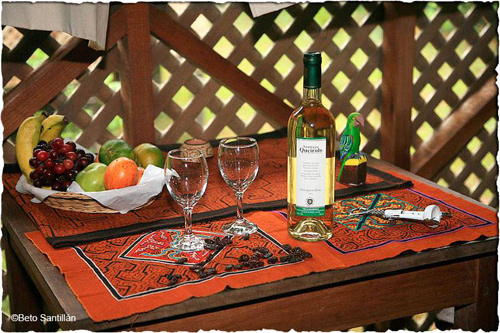
Meals
All meals are included in the trip from the breakfast on the 2nd day to the breakfast on the last day. Meals in Puerto Maldonado not included.
We believe that our guests should experience as much of the Peruvian cuisine as possible and this is reflected in the range of Peruvian dishes offered, with an occasional international twist. Typical lunch and dinner dishes served are lomo saltado (a spicy mix of stir fried beef, tomato, peppers, onion and French fries) and arroz con pollo (a mildly spicy mix of saffron rice, chicken and vegetables). When possible, fruit and vegetables are bought from the few families who live in the area.
Alcoholic drinks are not included with lunch or dinner. We a have a bar in the lodges where you can purchase alcohol.
Dietary Restrictions
We can cater to most dietary restrictions if given prior notice. Our experienced kitchen personnel can also cater for special dietary requirements, such as low or no salt, low or no sugar, low or no fat, and vegetarian (strict "vegan" or "ovo-lacto vegetarian), upon request.
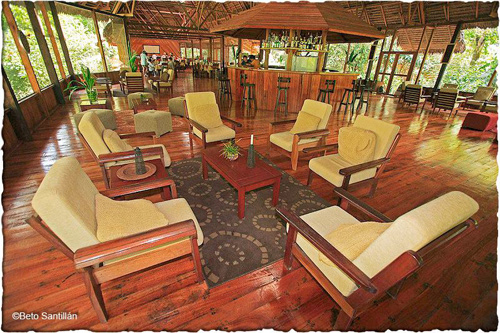
Riding
In Case Of Flight Cancellation
If the plane is canceled whilst the guests are waiting to return to Cusco, arrangements must be made with their guide for accommodation. Guests must pay for any additional costs incurred during this extra night. If the guests decide to go to Manu Wildlife Center for an additional night (SPACE PERMITTING), and return to Boca Manu the following day, the guests must pay an additional USD 60.00 for the extra night and boat transportation (USD 190 irrespective of the number of passengers) .
Health
Though we have never heard of anyone contracting yellow fever anywhere in Peru or neighboring countries Peru nevertheless requires a current yellow fever vaccination for trips to the rain forest regions. This vaccination normally is required or recommended for all rain forest regions around the world. This vaccination, which is valid for 10 years, must be administered AT LEAST 10 days before the guest's arrival in Peru.
Our Manu Wildlife Tented Camp has a basic first aid kit which also includes anti-venom. The lodge is equipped with a short-wave radio and is in contact with our Cusco office every morning and evening.
Hidden Trails highly recommends that our clients obtain a comprehensive travel and medical insurance before travel to Manu and anywhere in the world.
Itinerary
Sample Itinerary: 7-day program Manu & Beyond - subject to changes
Please, note that the program may vary slightly to maximize your wildlife sightings, depending on the reports of our researchers and experienced naturalist guides based at the lodge.
Day 1 (Tuesday): Arrival in Puerto Maldonado
Upon arrival, reception and transfer to your accommodation.
Meals included: none
Overnight at Cabaña Quinta Hotel in Puerto Maldonado
Day 2 (Wednesday): Puerto Maldonado to Manu Wildlife Center
Our service begins from 6:00 to 6:30 a.m. with a transfer service by van to Santa Rosa Village (about 2.5 hours). You will then cross the Inambari river (15 minutes boat trip) to reach Puerto Carlos. Here you will start your overland journey to Boca Colorado (45 minutes by car), followed by a 4.5 hours journey of motorized boat ride upstream the Madre de Dios river. We will arrive to Manu Wildlife Center for lunch.
Later, we make our first acquaintance with the rainforest, exploring some of the 30 miles of forest trails that surround the lodge. We have an excellent chance of encountering some of the 12 species of monkeys, including the Spider Monkey and Emperor Tamarin.
After dinner there will be an enchanting night walk along the trails, in search of the nocturnal birds and animals of the rainforest.
Meals included: Breakfast, Lunch & Dinner
Overnight at Manu Wildlife Center
Day 3 (Thursday): Manu Wildlife Center to Manu National Park
Another early start (inevitable on wildlife expeditions). Delicious breakfast followed by a boat journey (motorized canoe) up the Madre de Dios River. We make a short visit to the village of Boca Manu, riverside capital of the remote and sparsely populated Peruvian province of Fitzcarrald. The main activity here is building dugout boats for travelers on the river, and we see how these sturdy craft are made. Logging is prohibited here, so the resourceful villagers work entirely with lumber brought downriver by floodwaters.
Now we turn northward up the chocolate-brown waters of the Manu River into the lake-rich lower Manu National Park. The pristine quality of the forest is instantly apparent, with abundant birdlife and no signs of outside development. We check into the park at Limonal ranger station and then proceed upstream, as our boat driver steers skillfully through shallows and driftwood snags. Orinoco Geese and Horned Screamers strut on the beaches, Capped and White-necked Herons patrol the shoreline, and countless sunbathing turtles dive off their log perches as we approach.
After some 6 hours on the river we reach the Manu Park Wildlife Center, a simple but comfortable low-impact lodge nestled almost invisibly in the forest.
Time permitting, we will take a short walk before dinner to stretch our legs and enjoy our first encounter with virgin rainforest.
Meals included: Breakfast, Lunch & Dinner
Overnight at Manu Park Wildlife Center
Day 4 (Friday): Cocha Salvador & Cocha Otorongo
Today we visit two lakes near our camp. Park authorities determine the time of our visit to Cocha (Lake) Salvador; depending on this schedule, we will visit Cocha Otorongo earlier or later in the day.
Our trail to Cocha Otorongo begins some 30 minutes downstream from the camp. This brief river journey to the trailhead can always offer the chance of a thrilling wildlife sighting. Perhaps we will spot a family of capybaras, the world’s largest rodent, looking like giant Guinea Pigs as they browse on the riverbank, or if we are very lucky, a solitary jaguar might stalk slowly off an open beach into the forest, flicking its tail in annoyance at our intrusion.
On the short trail to the lake we may spy one or more of the park’s 13 monkeys species leaping through the canopy high above. And some of the trees, which form that canopy -- such as kapok, ironwood and figs, will astound us with the vast size of their trunks and buttressed root systems.
There are oxbow lakes, formed when the river changed course, leaving a landlocked channel behind. The lakes are abundant in fish and wildlife, and provide optimum habitat for caimans and the Giant Otter (Pteronura brasiliensis), one of the Amazon’s most endangered mammal species. This lake enjoys maximum protection, and boats are not allowed. However, it features two dock platforms and a 50ft tower from which to scan the trees and marshy shoreline for monkeys, kingfishers, Anhinga (a large, long-necked waterbird), and countless other species. We have a good chance of sighting the resident Giant Otter family as they dive for fish.
Cocha Salvador is the largest of the area’s lakes, at 3.5 Km, or some two miles long. It is also home to a family of Giant Otters. We cruise the lake on a floating catamaran platform, which offers superb new perspectives of lake and forest. The lakeside trees are often alive with monkeys; Scarlet, Chestnut-fronted and Blue-and-gold macaws beat a path overhead; a variety of herons and egrets scout the water’s edge; and the reptilian eyes and snouts of caimans, motionless as logs, may be spied beneath the branches.
Meals included: Breakfast, Lunch & Dinner
Overnight at Manu Park Wildlife Center
Day 5 (Saturday): Manu National Park
Very early, after breakfast, we will leave the Manu Park Wildlife Center, in order to travel upstream the Manu River until the Pakitza guard post (about 1 hour). We will explore the pristine nature around Pakitza, also looking for more wildlife - doing some activities such as boat rides to search for mammals, caimans, birds, as well as we will explore the forest where birds and mammals are plentiful, but basically we will spend this day searching some jaguars (if we are lucky).
Meals included: Breakfast, Lunch & Dinner
Overnight at Manu Park Wildlife Center
Day 6 (Sunday): Macaw Clay Lick Project and Tapir Clay lick
We set off downriver at dawn. At this hour, chances of wildlife encounters are excellent. We return to the Limonal park station, to file our wildlife report before leaving the park. After reaching the turbulent union of the Alto Madre de Dios and Manu Rivers and then the village of Boca Man. After 90 more minutes downstream we arrive at Manu Wildlife Center in time for lunch.
After a delicious lunch we walk through the forest for some minutes, where we find the Macaw Lick project. The hide provided with individual chairs and a convenient place for cameras and binoculars to a distance of 15 meters. In groups of two and three, the scarlet Macaws come flapping in, landing in the treetops as they eye the main stage below. Later, we continue to explore and discover the rainforest, its lore and plant life, on the network of trails surrounding the lodge, arriving in the late afternoon at our 34m/112ft Canopy Tower. From the platform, we witness the frantic rush-hour activity of twilight in the rainforest canopy, before night closes in.
Then we set off along the “collpa trail”, which will take us to the lodge’s famous Tapir Clay lick. Here at the most active tapir lick known in all the Amazon, our research has identified from 8-12 individual 600-pound Tapirs who come to this lick to eat clay from under the tree roots. This unlikely snack absorbs and neutralizes toxins in the vegetarian diet of the Tapir, the largest land animal of Latin America. The lick features a roomy, elevated observation platform 5m/17ft above the forest floor. The platform is equipped with freshly-made-up mattresses with pillows. Each mattress is covered by a roomy mosquito net. The 10-m-long, elevated walkway to the platform is covered with sound-absorbing padding to prevent our footsteps from making noise. This Tapir Experience is unique and exciting because these normally very shy creatures are visible up close, and flash photography is not just permitted, but encouraged. The hard part for modern city dwellers is to remain still and silent anywhere from 30 minutes to two or more hours. Many prefer to nap until the first Tapir arrives, at which point your guide gently awakens you to watch the Tapir 10-20m/33-66ft away, below the platform. Most people feel that the wait is well worth it in order to have such a high probability of observing the rare and elusive Tapir in its rainforest home.
Meals included: Breakfast, Lunch & Dinner
Overnight at Manu Park Wildlife Center
Day 7 (Monday): Departure
We leave our lodge very early for our 2.5 hours boat trip downstream to the Colorado Village. Depending upon the time we must be in Puerto Maldonado, the breakfast will be served at the lodge or on the boat while you enjoying early morning wildlife activity as we go. Of course this is a perfect time to take advantage of valuable early morning wildlife activity along the river. In addition, this journey allows us to see several lowland native settlements and gold miners digging and panning gold along the banks of the Madre de Dios River. We will stop in the far-west type gold-mining town of Colorado to start our overland journey to Puerto Carlos for 45 minutes, then you will cross the Inambari River for 15 minutes boat trip to Santa Rosa. Finally a van or bus will drive us for approximately 2.5 hours to the airport in Puerto Maldonado City.
Meals included: Breakfast
--------------------------------------------------------------------------------------------------------
Sample Itinerary: 6-day program Manu Wildlife - subject to changes
Please, note that the program may vary slightly to maximize your wildlife sightings, depending on the reports of our researchers and experienced naturalist guides based at the lodge.
Day 1 (Wednesday): Arrival in Puerto Maldonado
Upon arrival, reception and transfer to your accommodation.
Meals included: none
Overnight at Cabaña Quinta Hotel in Puerto Maldonado
Day 2 (Thursday): Puerto Maldonado to Manu Wildlife Center
Our service begin from 6:00 to 6:30 a.m. with a transfer service by van to Santa Rosa Village (about 2.5 hours). You will then cross the Inambari river (15 minutes boat trip) to Puerto Carlos. Here, you will start your overland journey to Boca Colorado (45 minutes by car), followed by a 4.5 hours boat journey upstream the Madre de Dios river. We arrive to Manu Wildlife Center for lunch.
Later, we make our first acquaintance with the rainforest, exploring some of the 30 miles of forest trails that surround the lodge. We have an excellent chance of encountering some of the 12 species of monkeys, including the Spider Monkey and Emperor Tamarin, which inhabit the surrounding forest.
After dinner there will be an enchanting night walk along the trails, in search of the nocturnal birds and animals of the rainforest.
Meals included: Breakfast, Lunch & Dinner
Overnight at Manu Wildlife Center
Day 3 (Friday): Macaw Clay, Canopy Tower & Tapir Clay lick
Another early start (inevitable on wildlife expeditions). After a delicious breakfast, we head to the Macaw Clay Lick near Tambo Blanquillo. In groups of two and three, the scarlet Macaws come flapping in, landing in the treetops as they eye the main stage below. After this we return to the lodge for lunch.
Later, we continue to explore and discover the rainforest, its lore and plant life, on the network of trails surrounding the lodge, arriving in the late afternoon at our 34m/112ft. Canopy Tower. From the platform, we witness the frantic rush-hour activity of twilight in the rainforest canopy, before night closes in.
Then we set off along the “collpa trail”, which will take us to the lodge’s famous Tapir Clay lick. Here at the most active tapir lick known in the entire Amazon, our research has identified from 8-12 individual 600-pound Tapirs who come to this lick to eat clay from under the tree roots. This unlikely snack absorbs and neutralizes toxins in the vegetarian diet of the Tapir, the largest land animal of Latin America. The lick features a roomy, elevated observation platform 5m/17ft above the forest floor. The platform is equipped with freshly made up mattresses with pillows. Each mattress is covered by a roomy mosquito net. The 10-m-long, elevated walkway to the platform is covered with sound-absorbing padding to prevent our footsteps from making noise. This Tapir Experience is unique and exciting because these normally very shy creatures are visible up close, and flash photography is not just permitted, but encouraged. The hard part for modern city dwellers is to remain still and silent anywhere from 30 minutes to two or more hours. Many prefer to nap until the first Tapir arrives, at which point your guide gently awakens you to watch the Tapir 10-20m/33-66ft) away below the platform. Most people feel that the wait is well worth it in order to have such a high probability of observing the rare and elusive Tapir in its rainforest home.
Meals included: Breakfast, Lunch & Dinner
Overnight at Manu Wildlife Center
Day 4 (Saturday): Hike to an Oxbow Lake & Wildlife Trails
We set off early for an old oxbow lake full of water lilies (Nuphar lutea) and sunken logs. As we circle the lake on our catamaran we might encounter the resident Giant Otter family on a fishing expedition, or troops of monkeys crashing noisily through the trees. Wattled Jacanas step lightly on the lily pads, dainty Sun Grebes paddle across the water, supple-necked Anhinga air-dry their wide, black wings, and perhaps an Osprey scans for fish from a high branch. Among the bushes near the waterline, Hoatzins, which look like rust-colored, punk chickens, announce their presence with distinctive, bizarre wheezing and grunts. Woodpeckers, tanagers, macaws, toucans and parakeets all finally come swooping in to trees surrounding the lake. Many of them roost around the lake for the night.
After lunch at the lodge, our guide is available to lead us on freewheeling expeditions in search of further wildlife encounters, or we may take one of the lodge’s many trails on private and personal excursions.
This evening, from the late afternoon until after Dinner, we offer an opportunity to search for caiman and other nocturnal life along the riverbank by boat (If the level of river allows it).
Meals included: Breakfast, Lunch & Dinner
Overnight at Manu Wildlife Center
Day 5 (Sunday): Observation tower & Trail system
After breakfast, we will explore the network of trails, having more emphasis in visiting trees that are with flowers and fruits, thanks to the information of our resident and naturalist guides. We expect to find more species of monkeys, as well as also numerous species of birds.
Before or after dinner, those who have energy and want more experience will have the second opportunity to visit the Observation Tower as well as The mammals or tapir clay lick.
Meals included: Breakfast, Lunch & Dinner
Overnight at Manu Wildlife Center
Day 6 (Monday): Departure
We leave our lodge very early on the 2.5 hours boat trip downstream to the Colorado Village. Depending upon the time we must be in Puerto Maldonado, the breakfast will be served at the lodge or on the boat while you enjoying early morning wildlife activity as we go. Of course this is a perfect time to take advantage of valuable early morning wildlife activity along the river. In addition, this journey allows us to see several lowland native settlements and gold miners digging and panning gold along the banks of the Madre de Dios River. We will stop in the far-west type gold-mining town of Colorado to start our overland journey to Puerto Carlos (45 minutes). Then you will cross the Inambari River (15 minutes boat trip) to Santa Rosa. Finally a van or bus will drive us (approximately 2.5 hours) to the airport in Puerto Maldonado City.
Meals included: Breakfast
Important note:
Beginning 02 March 2017 Bolivia and Brasil are requesting that all passengers must hold the proof of vaccination for Yellow Fever. This proof will be also requested in Peru to prevent and incidents as we have borders in common.
Rates and Dates for Manu Amazon Adventure
Rates include:
Accommodations, All meals (except first dinner), Park entrance fees, English-speaking guide & Local bus and boat transportation.
Rates Note:
Please, provide your passport information at time of booking
* prices are per person based on double/twin occupancy
Rates Note:
Please, provide your passport information at time of booking
Transfer and Other Charges:
|
2022
|
Transfer is included from Puerto Maldonado airport, return
|
|
2022
|
Discount for children under 10 - please inquire
|
Dates Note:
7-day trips are available every Tuesday to Monday in season.
Rates do not include:
Airport taxes, Drinks, Meals in Puerto maldonado (day 1), Gratuities, Optional activities not mentioned in the itinerary & Personal expenditures.
Other Info
Meeting: Puerto Maldonado airport
Airport: Puerto Maldonado airport
Transfer: Puerto Maldonado airport
Climate:
Puerto Maldonado area
|
Month
|
Jan
|
Feb
|
Mar
|
Apr
|
May
|
Jun
|
Jul
|
Aug
|
Sep
|
Oct
|
Nov
|
Dec
|
|
Average High Temperature (°F)
|
88
|
88
|
88
|
88
|
86
|
85
|
86
|
89
|
90
|
91
|
90
|
89
|
|
Average Low Temperature (°F)
|
72
|
72
|
72
|
70
|
68
|
65
|
64
|
66
|
68
|
71
|
71
|
72
|
|
Average High Temperature (°C)
|
31
|
31
|
31
|
31
|
30
|
29
|
30
|
32
|
32
|
33
|
32
|
31
|
|
Average Low Temperature (°C)
|
22
|
22
|
22
|
21
|
20
|
19
|
18
|
19
|
20
|
21
|
22
|
22
|
|
Average Precipitation (days of rain)
|
16
|
15
|
14
|
10
|
8
|
5
|
2
|
3
|
5
|
10
|
12
|
14
|
Source: NOAA
Seasons
Rainfall in the Manu Lowlands is around 2500-3500 millimeters/98-138 inches per year, with most rainfall occurring in the rainy season months from November to April. In the Manu Cloud Forest there is an annual rainfall of approximately 5000 millimeters/196 inches per year.
The average temperature in the Manu lowlands is 28°C (82°F), with daily highs of 34°C (93°F) and nightly lows of 22°C (72°F). During the dry season cold fronts from the South Atlantic (friajes) occur once every month or so, with daily temperatures dropping to 15°C (59°F) and nightly temperatures to 13°F (55°F).
The best time to visit is between April and December.
What To Bring:
* Good binoculars
* Camera gear (ASA 50, 100 and 200 recommended)
* Two or three pairs of long cotton pants
* Four pairs of absorbent socks.
* Rain suit or long poncho (100 % waterproof - test before you leave home)
* Two or three long-sleeved cotton shirts
* Two or three T-shirts.
* Sunscreen lotion (high factor)
* One pair of shorts
* A bottle or canteen to carry water on outings.
* A hat that will not come off in windy boat rides.
* Sunglasses
* A pair of sneakers or hiking boots and sandals.
* Insect repellent Skin-so-soft for river, and 20% or more deet for forest)
* A photocopy of your passport
* A bright flashlight
* Personal toiletries and medications
* Rubber boots.
* Cash for souvenirs, alcoholic beverages, etc.
We suggest you pack all items in plastic bags to protect them from water.
|
|